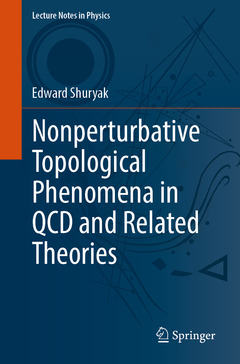Description
Nonperturbative Topological Phenomena in QCD and Related Theories, 1st ed. 2021
Lecture Notes in Physics Series, Vol. 977
Author: Shuryak Edward
Language: English
520 p. · 15.5x23.5 cm · Paperback
Description
/li>Contents
/li>Biography
/li>Comment
/li>
This book introduces a variety of aspects in nonperturbative Quantum Chromodynamics (QCD), focusing on the topological objects present in gauge theories. These objects, like magnetic monopoles, instantons, instanto-dysons, sphalerons, QCD flux tubes, etc, are first introduced individually and, later, treated collectively. As ensembles, they produce various phenomena that can be modeled numerically in lattice gauge theories and such collective effects, produced on the lattice, are extensively discussed in some chapters. In turn, the notion of duality, which is crucial in modern field/string theories, is elucidated by taking into consideration the electric-magnetic duality, the Poisson duality, and the AdS/CFT duality.
This monograph is based on various lectures given by Edward Shuryak at Stony Brook during the last three decades and it is meant for advanced graduate students and young researchers in theoretical and mathematical physics who are willing to consolidate their knowledge in the topological phenomena encountered in fundamental QCD research.Edward Shuryak was born in 1948 and grew up in Odessa, Ukraine. Winning the second place in Siberian Mathematics Olympiad, he was admitted into a special high school in 1964 and then into Novosibirsk State University, where he graduated in 1970 in Physics. Under the supervision of S.T. Belyaev, Shuryak received his Ph.D. in 1974 from the Budker Institute of Nuclear Physics, where he continued on as a researcher while simultaneously teaching at Novosibirsk State University. He became a full professor in 1982, the year in which he also gave the first series of lectures at CERN about quark-gluon plasma, a new form of matter for which he proposed the name in a 1978 paper. He moved to the United States in 1990 and became Professor of Physics at Stony Brook University, leading the Nuclear Theory Center. In 2004, Shuryak was promoted to Distinguished Professor, the highest academic appointment rank in the State University of New York system.
Shuryak is the author or co-author of nearly 400 papers which in total have been cited more than 32,000 times; four of these papers have been cited more than 1,000 each, and another nine have been cited more than 500 times each. His H-index is about 87, according to Google Scholar.
The outstanding scientific achievements of Edward Shuryak have been recognized internationally. He was elected as Fellow of American Physical Society in 1996, "for his seminal contributions to the study of the quark-gluon plasma". He was the 2004 recipient of the Dirac Medal from University of New South Wales in Australia and the 2005 recipient of the A. von Humboldt Prize from Germany. More recently at the 2018 APS April Meeting, he was awarded the 2018 Herman Feshbach Prize in Theoretical Nuclear Physics, "for his pioneering contributions to the understanding of strongly interacting matter under extreme conditions, and for establishing the foundations of the theory of quark-gluon plasma and its hydrodynamiGives a complete coverage of topological objects in nonperturbative QCD and their interrelation in gauge theories
Covers electroweak sphalerons and their role in baryon asymmetry of the universe and the physics of supersymmetric gauge theories
Presents a unique set of lectures, containing advance theoretical material in form accessible to graduate students
Provides useful discussions about the concept of duality in modern field theories
Authored by a lead expert in the field
These books may interest you

AdS/CFT Duality User Guide 34.80 €



